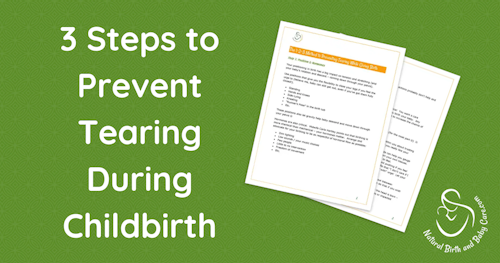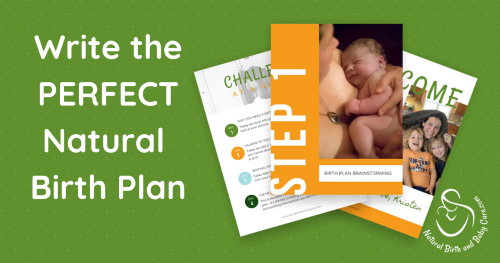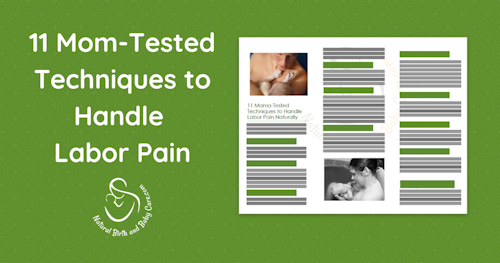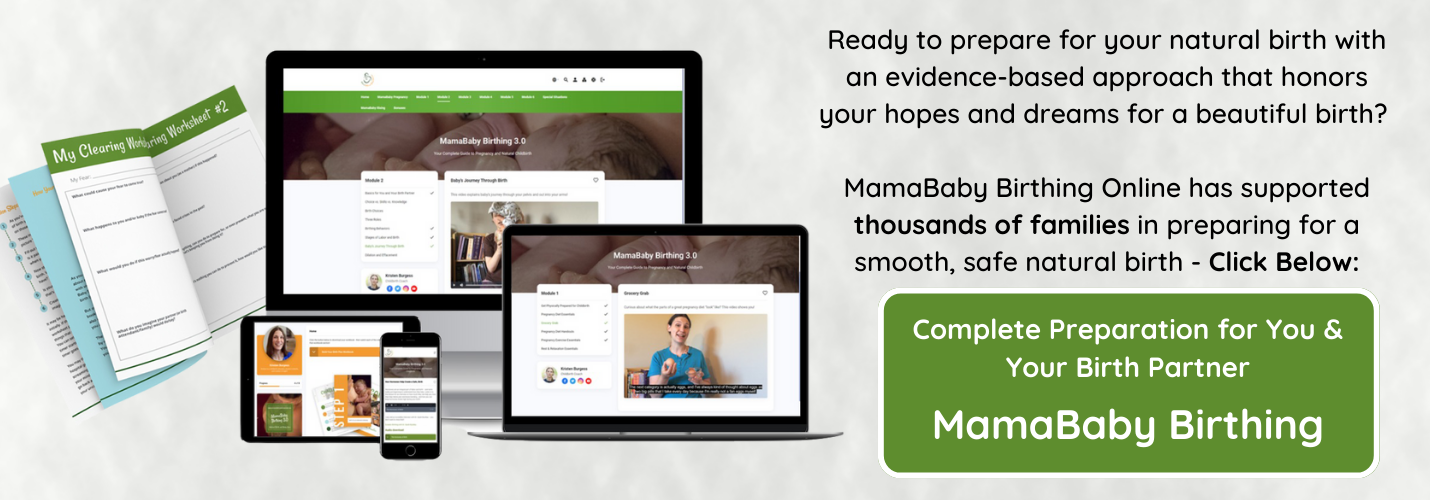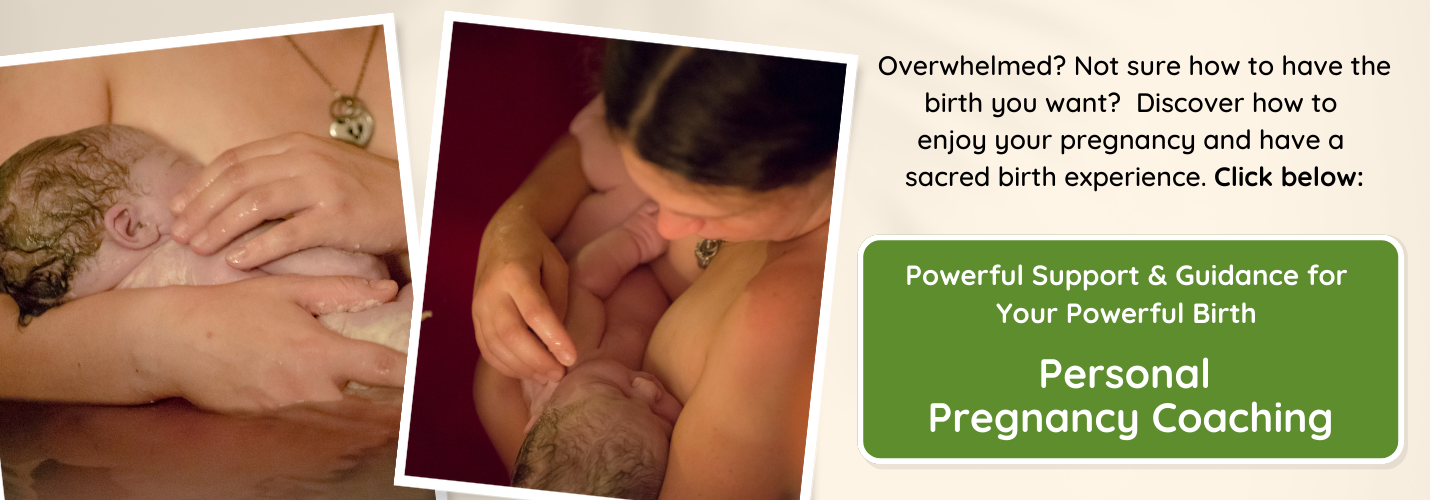I’ve been by way of childbirth 8 time – and after the primary couple of infants, I began trying into the right way to deal with the ring of fireside throughout a pure beginning with as little ache as attainable! I found some strategies that helped me push out infants with far much less ache – together with a 10lb 10oz child boy.
Utilizing perineal therapeutic massage and conditioning throughout being pregnant can scale back or forestall the “ring of fireside” throughout your child’s beginning. Through the beginning itself use place adjustments and respiration to sluggish pushing down and stop ache. You need to keep away from holding your breath and training pushing, if attainable, as a result of these usually make the ring of fireside a lot worse.
Nervous in regards to the ache of childbirth? Click on right here to read my natural pain relief techniques for earlier in labor, too!
What Causes the Ring of Fireplace Throughout Labor
(Plus How you can Deal With It)
Labor is a posh course of that docs and midwives divide into roughly three levels:
The “ring of fireside” sensation occurs in the course of the crowning portion of the pushing part of a vaginal beginning. At this level your child is nearly born – his or her head is simply inside the doorway to the beginning canal (the vaginal opening).
The burning, stinging sensation occurs as a result of your pores and skin begins to stretch to let the newborn’s head out. The realm surrounding the beginning canal is named your perineum, and this tissue stretches too.
(NOTE: Need 3 Easy Steps for a Easy, Light Pushing Stage? These strategies helped me beginning 8 infants (together with a 10lb, 10oz child boy) gently with NO tearing. Get the steps here.)
Crowning
“Crowning” historically meant when the newborn’s head utilized sufficient stress to create a gap the scale of an outdated British crown (coin) – and typically stinging sensations begin at that time.
Your physique continues to open till the pores and skin stretches round your child’s head like a crown on a queen – that is what most individuals take into account “crowning” immediately.
That is the purpose at which many ladies really feel burning and stinging. Chances are you’ll really feel one other stinging sensation when your child’s shoulders are born, however then it’s normally over (the placenta doesn’t typically sting or damage).
Historically, an episiotomy is finished as a result of the pores and skin is so stretched {that a} lady can’t really feel the scissors minimize the pores and skin.
We all know immediately, nevertheless, that an episiotomy just isn’t really helpful – and there’s rather a lot you are able to do to ease the ring of fireside and stop tears throughout beginning.
It is Potential to Have NO Ring of Fireplace!
As with handling transition there are steps to take throughout being pregnant to organize for pushing – doing these can imply no ring of fireside, like I found with a few of my births.
Right here’s a clip from my sixth child’s beginning – pushing him out was so mild and painless that no one else realized he was being born:
Earlier than your child’s beginning you’ll be able to:
Listed below are some steps to take throughout pushing:
Bear in mind, the ring of fireside happens proper earlier than your child is born – so you might be virtually there! It could final for a couple of contractions, however these strategies will enable you get by way of it – and to having your child in your arms!
(NOTE: Need a Excellent Start Plan Template? Use this template and step-by-step movies to write down a beginning plan that will get your beginning crew in your aspect for an exquisite beginning expertise! Get the birth plan kit here.)
3 Methods to Use Earlier than Labor to Stop the Ring of Fireplace
There are three methods to make use of throughout being pregnant to assist forestall or reduce the “ring of fireside” expertise whereas pushing your child out. I’ll discuss two on this part and commit a full part to the third.
Let’s begin out with two easy methods that work. I coated these in the post on handling transition during a natural birth, so that they’ll really feel acquainted when you already began on these ideas!
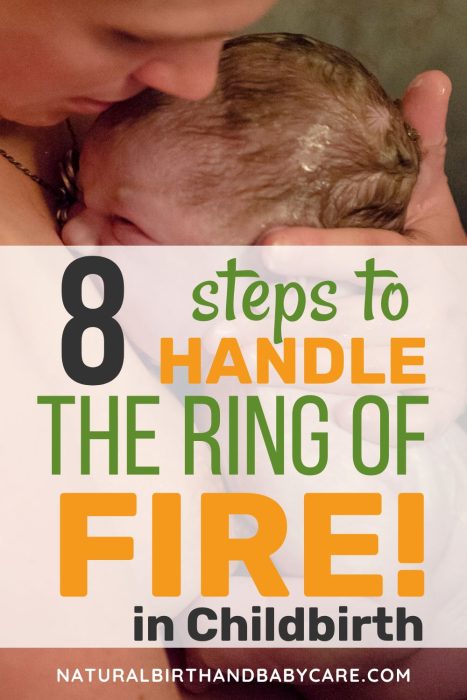
Situation Your self to Loosen up
First, situation your self to calm down your entire pelvic space. That is my #1 tip and it’s what helped me beginning my child with no ache throughout pushing (see the video above). Each time you go to the lavatory, apply stress-free your pelvic space.
You are able to do it with #1, because you’re most likely within the rest room on a regular basis. But additionally apply with #2 (even when you’re coping with some being pregnant constipation).
The stress of your child coming down feels rather a lot like needing a bowel motion, so conditioning your self to calm down towards that stress pays off.
Utilizing a Cue Phrase
I like to make use of a cue phrase – “soften” is an effective phrase, or “peace” (“peace” is the cue phrase I learned in Hypnobabies) Take a while to calm down your entire physique and sluggish your respiration, then really feel your pelvic tissues soften, too.
You may begin by clenching every little thing down there up – this helps you determine precisely which muscle groups to launch and hold tender throughout rest room journeys.
Say your cue phrase after which work on releasing your muscle groups out of your brow down, however focus most particularly on you pelvic space.
Do that each time you go to the lavatory and your physique turns into conditioned to it.
Discuss together with your beginning companion about it, too. You will not speak a lot once you’re in essentially the most intense elements of birthing your child.
Your beginning companion ought to know your cue phrase and methods that will help you. They will (calmly) remind you of your cue phrase and encourage you throughout pushing.
Want extra ideas in your beginning companion? Click here for my podcast episode on getting your birth partner ready to help during labor!
Respiration (the best approach) Actually is Key for the Ring of Fireplace
Second, work on respiration. Like with leisure, conditioning is essential right here. Follow inhaling by way of your nostril and out by way of your mouth.
An amazing tip for working towards to is to maintain ice cubes in your fingers whilst you apply. Or, have your companion maintain them behind your ear. It’s REALLY tough to maintain your physique tender and relaxed and hold your breath calm when somebody does this!
It’s additionally a enjoyable method to “apply” retaining calm in a tense scenario. This tip is from Pam England’s guide Birthing From Within, a basic being pregnant learn.
Inhaling by way of your nostril and out by way of your mouth whereas retaining your jaw open and relaxed immediately impacts your pelvic muscle groups – it helps hold them tender and open, making it simpler in your child to come back by way of.
Follow this respiration anytime you’re feeling winded or in need of breath. It’s additionally good to note the way you breathe once you’re calm and relaxed, burdened or indignant, excited, and so on.
Consciousness of your breath helps you utilize it when you should deal with the ring of fireside throughout pure beginning!
Further Being pregnant Ideas
Proof additionally means that an excellent pregnancy diet helps scale back perineal trauma – as does having an lively intercourse life throughout being pregnant (Dieb et al., 2019)!
(NOTE:Want Labor Pain Techniques that REALLY Work? Get these 11 mom-tested techniques for handling contractions from start to finish Get the mom-tested natural labor techniques here.)
The Evidence for Perineal Massage
The perineal tissues are the tissues (skin) surrounding the opening of the birth canal (the vagina). “The perineum” is the area of skin between the opening of the birth canal and the anus, and it’s where the pressure of the baby’s head will center.
All tissues surround the opening of the birth canal stretch for the baby, however, so perineal massage techniques tend to work with the perineum and the skin on the sides of the birth canal.
Evidence suggests that perineal massage makes a difference during birth, especially for first-time moms (Beckmann & Stock, 2013).
Doing it during pregnancy reduces tearing and helps with pelvic healing after birth – it’s something you can start in the third trimester. It can also help reduce the “ring of fire” effect while birthing your baby.
Some mamas feel timid about doing perineal massage because it involves touching the perineum and even just inside the birth canal. This can feel really intense, and even scary for women who may have a history of abuse.
Recent research in Japan showed that understanding perineal massage and having the encouragement of a midwife or childbirth educator can help women overcome shyness and use perineal massage (TAKEUCHI & HORIUCHI, 2014).
If you are a survivor of sexual abuse, talk to your doctor or midwife about getting support to prepare for birth – it can make a huge difference to have that support during a natural birth experience.
Based on research, 1-2 times a week is optimal for perineal massage.
How to do Perineal Massage
This handout from the NHS gives detailed, step-by-step instructions for perineal massage. This brochure from the Auckland District Health Board has color illustrations that may be helpful.
I used Birthing Better’s form of perineal massage – called the “Internal Work” to help prepare for my babies. Birthing Better has an mp3 track that guides you through the Internal Work, which was much easier for me to use than trying to use a handout!
The Internal Work is part of the collection of techniques to make labor and delivery smoother – for me they really paid off, as you saw in the video of Corwin’s birth above! Click here to read about the Internal work and cue words helped during Corwin’s birth.
The Pros and Cons of Perineal Support
Many midwives (or your delivery nurse) use perineal support of some type. They either put their hands or warm compresses over the skin of the perineum to provide support as the baby’s head is crowning and being born.
The evidence on these techniques is mixed. There appears to be some evidence that perineal warm packs reduce more severe tears of level 3 and 4 (the different degrees are on a scale of 1 to 4, with 4 being the most severe tear) (Aasheim et al., 2017).
But support and/or a warm perineal pack don’t stop smaller tears, including second degree tears.
In fact, some evidence supports that perineal massage may increase the risk of tearing in mamas who are having a second or later baby.
An Australian study showed no help or harm for first-time mothers, but all other mamas had an increase in tearing and injury to the perineum when the healthcare provider gave perineal support (Lee et al., 2018).
Rachel Reed covers more information on perineal support and episiotomy in her detailed blog post Perineal Protectors.
Looking for a natural childbirth course that’s evidence-based AND focused on honoring your intution and power during your birthing time?
Click here for details on MamaBaby Birthing, my complete online birthing course. Used by thousands of birthing families, you’ll be completely prepared for a beautiful, safe, and confident birth experience.
Bringing Your Own Baby Up
Here’s a personal thought that comes from having 8 babies, the last 5 of whom I birthed and brought up to my chest in my own hands – with no tearing (I didn’t tear with any of my babies).
I feel that part of natural birth is being able to fully experience what’s happening, and I reached down and instinctively felt my baby’s heads as they were being born.
Having an attendant’s hands down there would have gotten in the way. Having my hand there gave me a connection to my baby and helped me push at the right rate for my baby and myself. It is one of my favorite ways to handle the ring of fire during a natural birth!!!
I’ve talked with many women at this point, and many find they reach down to support their own perineum and make that first touch connection with their baby – to me, this is natural, and powerful <3
Your hands can be the ones to feel as baby crowns and is born!
Want more info on this? Check out my podcast on the best positions to catch your own baby!
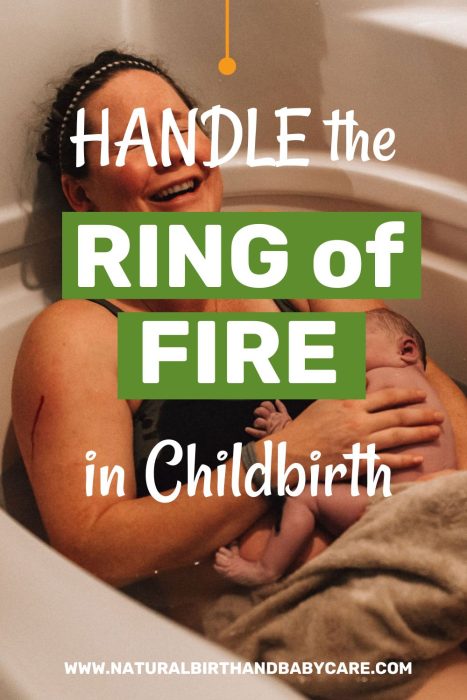
Birthing Positions to Handle the Ring of Fire
Birthing positions are important when you want to handle the ring of fire during natural birth because some of the positions actually increase the chance of tearing and intensity of the ring of fire.
Consider different positions to ease the pressure an intensity.
AVOID these positions:
Are you surprised I just recommended against a squat? Many women think it’s the “natural” way to give birth, but it puts immense pressure on the perineum and causes skin to stretch.
If you’ve grown up in a culture where squatting is the norm and you do it all the time, your skin is likely used to it and more supple. But it’s not the best position for most women to birth in.
Positions that put pressure on your lower back can slow the birthing process, make pain management more difficult, and increase the intense burning sensation during baby crowning.
Choose positions that give you more flexibility.
If you need to slow pushing down, side-lying is a good option (discussed below).
Here are positions that reduce tearing and help you handle the ring of fire during a natural birth:
Side-lying is a great position because you’re able to fully relax between contractions. Your partner or a birth attendant can hold your leg up at a comfortable angle while you push.
This a good position for mother-directed, slower pushing and to relieve pressure on your tissues, which helps you handle the ring of fire during a natural birth.
Hands-and-knees is often an instinctive position and works well for birth attendants, too. Attendants get a very clear view of the birth, but like side-lying, there’s much less pressure on the perineum.
You also have a lot of flexibility to move your body with the contractions, which helps some mamas. A disadvantage of this position is that it’s often difficult to use your own hands to touch your baby’s head or guide your baby out.
A semi-squat or semi-kneeling position is a great way to birth your baby. It’s a more upright position that gives you a lot of control. Because one knee is down, there’s a lot less pressure on your perineum and you can easily adjust to help slow things down.
This position is how I’ve birthed my last 5 babies.
Kneeling is a variation of the above that works well – both knees are down and you can more easily control pressure and tension on your perineum by adjusting how far apart your knees are.
The right position for you may be different than another woman. While you can’t practice for your baby crowning during pregnancy, you can try these different positions and see how they feel to your body. Notice tension and relaxation in your perineal tissue. Which position feels good?
While it’s especially important to do this during your first pregnancy, I recommend testing different positions even if this isn’t your first baby. Many women don’t realize they can give birth in different positions! And you’ll feel more comfortable with your body and moving into those positions if you’ve tried them before.
Looking for more information on birth positions? Click here for my detailed labor and birth position guide.
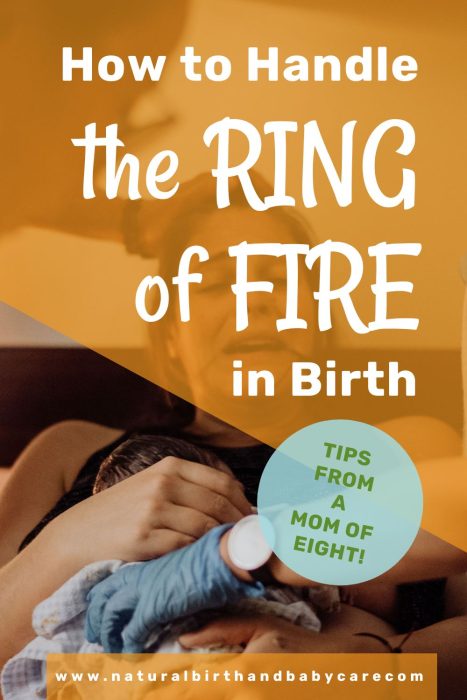
Final Tips for Handling the Ring of Fire During a Natural Birth
I’m a firm believer in the work you do during pregnancy to prepare yourself to relax and breathe through the intensity of pushing. Here are a couple more tips:
Mother-Directed Pushing: Don’t go with coached pushing. Sometimes first-time mamas need a little help understanding how to push. Your midwife or doctor can place one or two fingers on your perineum and tell you “push to here” – which generally helps immediately increase the effectiveness of pushing.
You can push when your body pushes (your uterus is going to push down regardless of what you do to help it!). You don’t have to push with your breath held – coached pushing can lead to more pain and lower umbilical cord oxygen levels for babies (Vaziri et al., 2016).
The Fetal Ejection Reflex is something you may hear talked about – when the body pushes the baby out on its own. This is highly likely during a natural birth where hormonal flow hasn’t been interrupted. But sometimes first-time mamas still have to push to help the baby out – just push on your own terms.
Consider Water Birth: Water offers a gentle counter-pressure on the soft tissues as the baby descends. It also supports all of your weight and your baby’s weight, reducing fatigue and helping you better control the rate of pushing.
Water birth is very safe for your baby and offers many benefits during both labor and pushing (Bailey et al., 2019; Carlsson & Ulfsdottir, 2020; Clews et al., 2019; Neiman et al., 2020).
Related Questions
What does the ring of fire feel like during birth? The ring of fire actually feels like a major stretching sensation with a lot of stinging and burning. It generally eases between contractions, but it’s sometimes intense at the peak of contractions.
When does the ring of fire begin during birth? There are three stages of labor and the ring of fire happens during the second stage, when you’re pushing your baby out. You won’t feel it during early labor.
How long does the ring of fire last? The ring of fire starts when the baby’s head reaches crowning and it usually ends after the shoulders are born. It can last from 1-5 contractions, or 2-20 minutes or so. It’s usually not continuous during that time, because it eases between contractions.
How do you stop the ring of fire in childbirth? I’ve covered a number of techniques to use during pregnancy, but the best way to stop the ring of fire during vaginal delivery is to change positions. This can be hard during pushing – but try to move to your side, hands and knees, or kneeling to reduce the pressure, provide pain relief, and birth your baby gently.
Gentle birth is the best way to handle the ring of fire during a natural birth – you can do it, mama <3
Want personal support to stay healthy and low-risk through your pregnancy? Longing for authentic guidance to make your sacred birth dream a reality?
Click to book a pregnancy and birth visioning call with me. We’ll talk about your hopes and dreams and explore if my pregnancy coaching program is a good fit for you.
The Labor Pain Management Series
References
-
1
Aasheim, V., Nilsen, A. B. V., Reinar, L. M., & Lukasse, M. (2017). Perineal techniques during the second stage of labour for reducing perineal trauma. Cochrane Database of Systematic Reviews. https://doi.org/10.1002/14651858.cd006672.pub3
-
2
Bailey, J. M., Zielinski, R. E., Emeis, C. L., & Kane Low, L. (2019). A retrospective comparison of waterbirth outcomes in two United States hospital settings. Birth, 98–104. https://doi.org/10.1111/birt.12473
-
3
Beckmann, M. M., & Stock, O. M. (2013). Antenatal perineal massage for reducing perineal trauma. Cochrane Database of Systematic Reviews. https://doi.org/10.1002/14651858.cd005123.pub3
-
4
Carlsson, T., & Ulfsdottir, H. (2020). Waterbirth in low‐risk pregnancy: An exploration of women’s experiences. Journal of Advanced Nursing, 1221–1231. https://doi.org/10.1111/jan.14336
-
5
Clews, C., Church, S., & Ekberg, M. (2019). Women and waterbirth: A systematic meta-synthesis of qualitative studies. Women and Birth. https://doi.org/10.1016/j.wombi.2019.11.007
-
6
Dieb, A. S., Shoab, A. Y., Nabil, H., Gabr, A., Abdallah, A. A., Shaban, M. M., & Attia, A. H. (2019). Perineal massage and training reduce perineal trauma in pregnant women older than 35 years: a randomized controlled trial. International Urogynecology Journal, 613–619. https://doi.org/10.1007/s00192-019-03937-6
-
7
Lee, N., Firmin, M., Gao, Y., & Kildea, S. (2018). Perineal injury associated with hands on/hands poised and directed/undirected pushing: A retrospective cross-sectional study of non-operative vaginal births, 2011–2016. International Journal of Nursing Studies, 11–17. https://doi.org/10.1016/j.ijnurstu.2018.04.002
-
8
Neiman, E., Austin, E., Tan, A., Anderson, C. M., & Chipps, E. (2020). Outcomes of Waterbirth in a US Hospital‐Based Midwifery Practice: A Retrospective Cohort Study of Water Immersion During Labor and Birth. Journal of Midwifery & Women’s Health, 216–223. https://doi.org/10.1111/jmwh.13033
-
9
TAKEUCHI, S., & HORIUCHI, S. (2014). Why don’t pregnant women practice antenatal perineal massage?: Journal of Japan Academy of Midwifery, 173–182. https://doi.org/10.3418/jjam.28.173
-
10
Vaziri, F., Arzhe, A., Asadi, N., Pourahmad, S., & Moshfeghy, Z. (2016). Spontaneous Pushing in Lateral Position versus Valsalva Maneuver During Second Stage of Labor on Maternal and Fetal Outcomes: A Randomized Clinical Trial. Iranian Red Crescent Medical Journal. https://doi.org/10.5812/ircmj.29279

Trending Merchandise

Frida Baby Medicine Pacifier, Medi Frida Baby Medicine Syringe & Accu-Dose Pacifier, Baby Medicine Dispenser for Mess & Fuss Free Use


